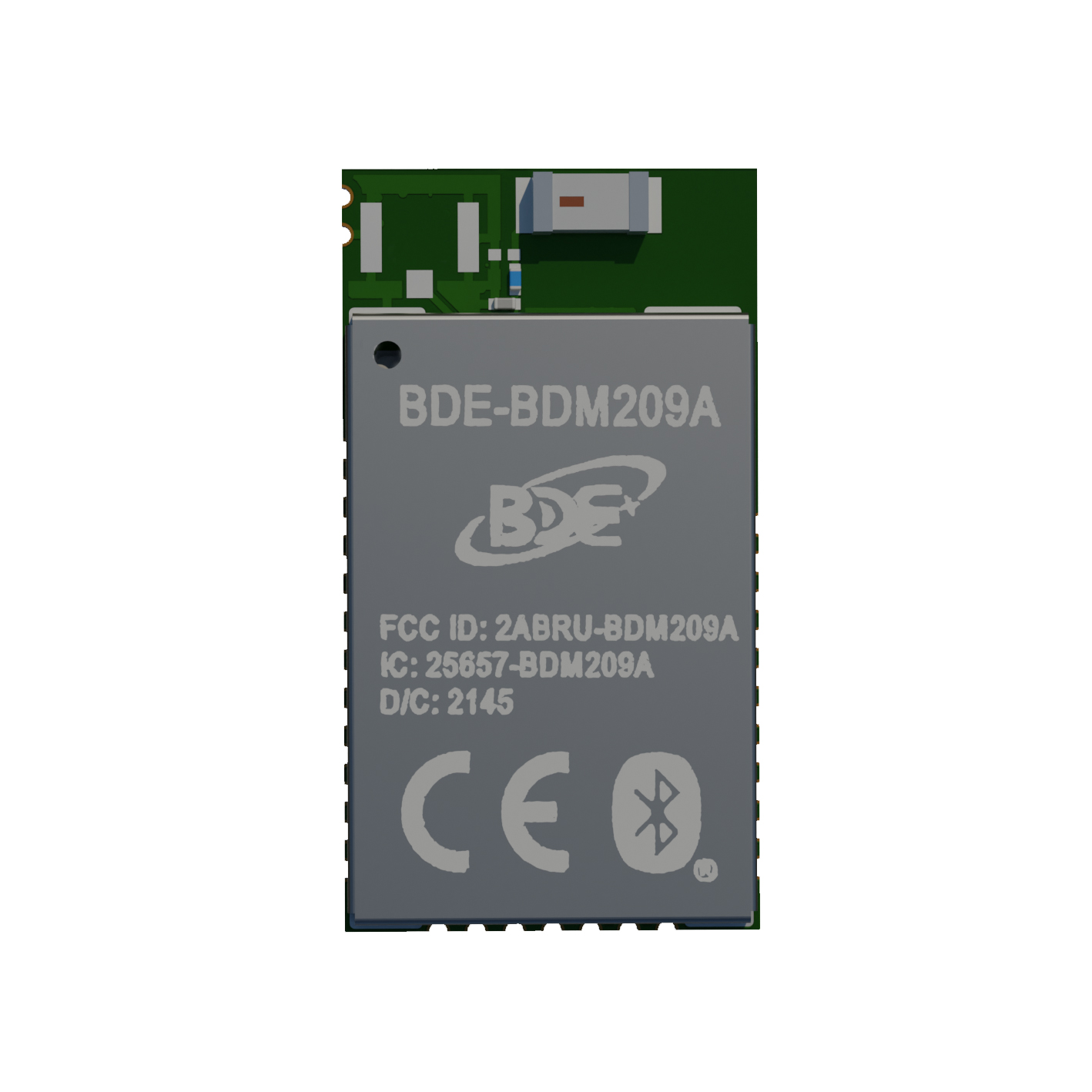Location:Home - Products
Products
Bluetooth Dual-Mode - BDE-BDM209A (Bluetooth 5.1 Dual-Mode Based on MSP432 and CC2564C)
- BDE-BDM209A (Bluetooth 5.1 Dual-Mode Based on MSP432 and CC2564C)
- General DescriptionBDE-BDM209A is a Bluetooth 5.1 BR/EDR & Bluetooth 5.1 Low Energy Dual Mode module.The module offers a unique combination of Bluetooth® classic and Bluetooth Low Energy radio TI’s CC2564C and an ARM 32-bit Cortex-M4F CPU MSP432, with integration of all external components including antenna at a very affordable cost.The module provides the best-in-class RF performance with transmit power and receive sensitivity that provides twice the range and higher throughput than other Bluetooth-low-energy-only solutions. The power-management hardware and software algorithms provide significant power savings in all commonly used Bluetooth® BR/EDR and low energy modes of operation.The certified and royalty free Dual-mode Bluetooth® 5.1 protocol stack software provides a complete Bluetooth® BR/EDR, and Bluetooth Low Energy sample applications that reduce design effort and ensure a faster time to market.Key Features-Processing and memories- Arm® 32-bit Cortex®-M4F CPU with floating point unit and memory protection unit- Frequency up to 48 MHz- 256KB flash main memory (organized into two banks enabling simultaneous read or execute during erase)- 16KB of flash information memory- 64KB of SRAM (including 6KB of backup memory)- 32KB of ROM with MSP432™ peripheral driver libraries- Bluetooth® 4.2 Declaration ID D049226- BR and EDR Features Include:- Up to Seven Active Devices- Scatternet: Up to Three Piconets Simultaneously, One as Master and Two as Slaves- Up to Two Synchronous Connection Oriented (SCO) Links on the Same Piconet- Support for All Voice Air-Coding—Continuously Variable Slope Delta (CVSD), A-Law, μ-Law, and Transparent (Uncoded)- Assisted Mode for HFP 1.6 Wideband Speech (WBS) Profile or A2DP Profile to Reduce Host Processing and Power- Support of Multiple Bluetooth® Profiles with Enhanced QoS- Bluetooth Low Energy Features Include:- Support of up to 10 Simultaneous Connections- Multiple Sniff Instances Tightly Coupled to Achieve Minimum Power Consumption- Independent Buffering for Low Energy Allows Large Numbers of Multiple Connections Without Affecting BR or EDR Performance- Built-In Coexistence and Prioritization Handling for BR, EDR, and Low Energy- Best-in-Class Bluetooth® (RF) Performance (TX Power, RX Sensitivity, Blocking)- Class 1.5 TX Power up to +10 dBm- –93 dBm Typical RX Sensitivity- Internal Temperature Detection and Compensation to Ensure Minimal Variation in RF Performance Over Temperature, No External Calibration Required- Improved Adaptive Frequency Hopping (AFH) Algorithm with Minimum Adaptation Time- Provides Longer Range, Including Twice the Range of Other Low-Energy-Only Solutions- Advanced Power Management for Extended Battery Life and Ease of Design- Low Power Consumption for Active, Standby, and Scan Bluetooth® Modes- Shutdown and Sleep Modes to Minimize Power Consumption- MCU Ultra-low-power operating modes when Bluetooth® is Shutdown- Active: 80 μA/MHz- Low-frequency active: 83 μA at 128 kHz- LPM3 (with RTC): 660 nA- LPM3.5 (with RTC): 630 nA- LPM4: 500 nA- LPM4.5: 25 nA- Operating characteristics- Wide supply voltage range: 2.05V to 3.7V- Temperature range: –40°C to 85°C- Flexible clocking features- Tunable internal DCO (up to 48 MHz)- 32.768-kHz low-frequency crystal support (LFXT)- High-frequency crystal support (HFXT) up to 48 MHz- Low-frequency internal reference oscillator (REFO)- Very low-power low-frequency internal oscillator (VLO)- Module oscillator (MODOSC)- System oscillator (SYSOSC)- Code security features- JTAG and SWD lock- IP protection (up to four secure flash zones, each with configurable start address and size)- Enhanced system features- Programmable supervision and monitoring of supply voltage- Multiple-class resets for better control of application and debug- RTC with calendar and alarm functions- Timing and control- Up to four 16-bit timers, each with up to five capture, compare, PWM capability- Two 32-bit timers, each with interrupt generation capability- Physical Interfaces:- UART with automatic baud-rate detection- I2C (with multiple-slave addressing)- SPI (up to 16 Mbps)- Up to 17 GPIOs for users- All GPIOs with capacitive-touch capability- Ultra-low-leakage I/Os (±20 nA maximum)- Up to 15 I/Os with interrupt and wake-up capability- Two I/Os with glitch filtering capability- Fully Programmable Digital Pulse-Code Modulation (PCM)–I2S Codec Interface- Antenna: Chip antenna or U.FL connector- Encryption and data integrity accelerators- 128-, 192-, or 256-bit AES encryption and decryption accelerator- 32-bit hardware CRC engine- Bluetooth® 5.1 Dual-mode stack- Dual-mode Bluetooth® 5.1 certified and royalty free- Classic Bluetooth® Profiles Available- A2DP1.2, AVDTP1.2, AVRCP1.3, HSP1.2, GAP, HID1.0, MAP1.0, PBAP1.0, RFCOMM, SDP, SPP.- Bluetooth Low Energy Profiles Available- ANS1.0, BAS1.0, CSCS1.0, DIS1.0, FMP1.0, GAPS1.0, GATT1.0, HTS1.0, HRS1.0, HIDS1.0, IAS1.0, LLS1.0, PASS1.0, PXP1.0, TPS1.0.- MFi Support- iAP Protocol (iAP 1/iAP 2) provided as an add-on upon request- Packaging- 12 mm x 22 mm x 2.1 mm package- Large variety of Sample Applications- Classic Bluetooth® Sample Applications include: A3DP Sink/Source, HFP, HID, HSP, MAP, PBAP, SPP application demos.- Bluetooth 5.1 Low Energy Sample Applications include: ANP, iBeacon, HRP, HTP, PASP, HOGP, PXP, FMP, CSCP application demos.- Classic Bluetooth® + Bluetooth Low Energy Sample Applications include: SPP+SPPLE, SPP DMMulti application demos.- Development Environment supports:- CCS, Keil®, and IAR Embedded Workbench® IDEs.- Standards Conformance- Bluetooth®- DID: D054396, QDID: 165249- FCC ID: 2ABRUBDM209A- IC: 25657-BDM209A- CE-RED- Japan- Korea- Taiwan- Australia- New Zealand- ChinaDownload
- Next: BDE-BD2564CA (Bluetooth 5.1 Dual-Mode Based on CC2564C)
Copyright © 2021 BDE Technology. All rights reserved|Chicago, Illinois 60603


